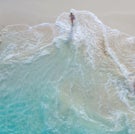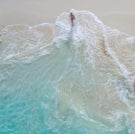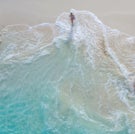“Well… no one said storm watching would be easy,” my partner said with a wild look in his eye, having just plunged up to his knee in an unexpectedly deep patch of snow. I turned and nodded, but my mind was elsewhere, too preoccupied with how exactly to make it up this hill without rolling back down again.
“Right or left?” I signalled back to him before forging ahead, too eager to wait for a response. Time to pick up the pace. The wind from the nearby shoreline was turning from breeze to gale, and the thick layer of cloud over head was becoming a deeper, far moodier shade of grey.
Not the archetypal holiday, I’ll admit, but here on Norway’s west coast, where the country’s deep fjords meet rough and roaring seas, storm watching has been growing in popularity for thrill seekers and nature lovers.
Ask any one of the country’s residents who live across the west coast’s exposed islands, and they’ll tell you storm watching is a state of mind. A chance to destress from your daily life, take in some amazing views and experience nature at some of its wildest. Just don’t forget your wellies.
Head out during the winter months they said, so it seemed we’d timed our trip to perfection. Our plane touched down amid heavy snowfall. “The heaviest in 20 years,” according to one local I got chatting to after arriving in Bergen, Norway’s second-largest city and a good jumping off point for storm watching activities given its location on the west coast.
We had plotted a route north, travelling up the coastline. The plan was island-hopping via postal boat, hiking across heather-strewn craggy rocks, meeting wild sheep for the first time and foraging in the rain through sodden peat bogs against a backdrop of distant crashing waves.
Read more on Europe travel:
With Bergen a 40-minute drive from the site of two abandoned wave power stations in Vik, in the municipality of Øygarden, we detoured here first. Positioned on a peninsula, the plants previously generated electricity from the large coastal waves that would crash down through a funnel in the coastline.
Rather ironically, however, they were destroyed by a massive storm just three years after being built in 1985. Today, companies like Øygarden Opplevelser can get you up close via a RIB boat if weather permits, but on choppier seas you can still catch a glimpse on foot.
Our trip took a turn for the surreal the next day after catching a ferry to a small island called Hille. With the sun setting not long after 4pm in January, it was pitch black when we arrived, and rain started to fall right on cue. We were greeted by Eva and Svein, the only two people living on the island aside from John, Svein’s dad, and their border collie, Bill.
Usually a summer destination, they agreed to open the glamping dome for the night given its ideal location on the seafront for storm watching, but with Storm Isha approaching they braced us for a windy night ahead. Very windy. Eva explained they’re soon to replace the glamping with a panoramic house so people can visit year-round.
The two-minute trip to the dome, which was glowing in the distance like some far-off igloo, was via a monster quad bike fixed with a small trailer. It chugged us slowly over ice-encrusted hills as an excited Bill ran ahead and I prepared my mind and body for the imminent mad dash to the outside hot tub in nothing but my swimsuit.
A bottle of the excellent locally brewed cider gave me the Dutch (Norwegian?) courage I needed to make a bolt for the tub, my look completed by a yellow fisherman’s hat that I’d strapped on in a desperate attempt to keep the rain off.
Lying back amongst the hot tub’s warm bubbles the chill soon faded, leaving me to enjoy the moonlit silhouettes of the surrounding fjords. It took some convincing to get me out again into the chaos of the storm and the booming winds that shook the dome throughout the night, keeping me awake with visions of us blowing out to sea like some giant tumble weed.
Another ferry and bus took us further north to the Solund archipelago, home to 1,700 islands, islets and skerries where, wrapped in padded storm suits, we headed out for a guided storm watching hike across giant grassy boulders.
This part of Norway is known for its nature and within minutes we spotted a sea otter scrabbling up the rocks just metres away and an eagle soaring overhead. On the cliff edge, we were at the mercy of wild winds that propped you up one minute and knocked you down the next.
We took refuge in one of the public walking huts found dotted around Norway’s landscape, which have log fires to dry off from the wild weather.
I started the following day island-hopping in a postal boat before being taken out with locals, Kjell and Jordy for a ‘wild sheep safari’. In addition to acting as storm watching guides, they tend the sheep during winter to make sure they’re healthy and fed and arrange woolly meet-and-greets with tourists. This was the first time I had encountered a wild sheep and I was not expecting them to be so sociable.
Our final stop was on the exposed island of Fedje, where 25 storms apparently raged in one month during 2022. “Fedje is hardcore,” as one local put it. Okay then, a testing finale. We set off to forage for sea truffle, a vegetable that grows in tufts alongside kelp in rough water and tastes a lot like crab.
We crossed soggy peat bogs and thick patches of heather, climbed down ladders, up boulders and across one precarious wooden plank to reach the shoreline. There the island’s lighthouse was lit by a golden haze in the distance, the North Sea waves rolled fiercely against the rocks; and I finally felt calm amid the storm.
Travel essentials
How to get there
Flights from London Gatwick to Bergen with Norwegian start at £73 return.
Where to stay
Bergen Børs Hotel
This grand hotel in Bergen’s old stock exchange building has classic-contemporary rooms and a great bar that serves cocktails and local beer.
Learn more
Solund Apartement Hotel
This hotel in the centre of Hardbakke has 11 apartments with their own kitchen, bathroom dining and living area. Doubles from £134.
best places see the Northern Lights around the world – and when to visit
Source: independent.co.uk



